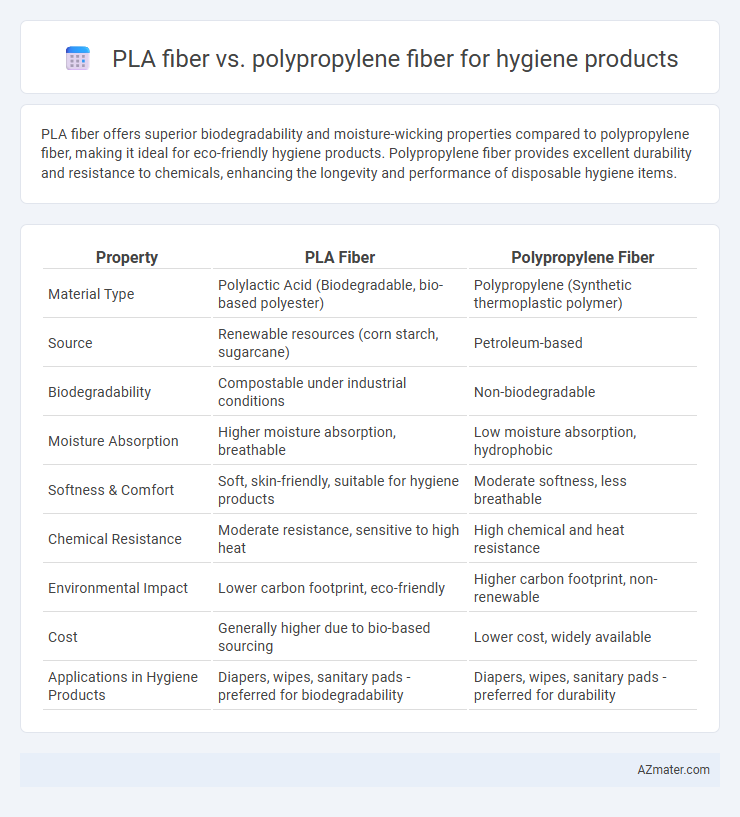PLA fiber offers superior biodegradability and moisture-wicking properties compared to polypropylene fiber, making it ideal for eco-friendly hygiene products. Polypropylene fiber provides excellent durability and resistance to chemicals, enhancing the longevity and performance of disposable hygiene items.
Table of Comparison
| Property | PLA Fiber | Polypropylene Fiber |
|---|---|---|
| Material Type | Polylactic Acid (Biodegradable, bio-based polyester) | Polypropylene (Synthetic thermoplastic polymer) |
| Source | Renewable resources (corn starch, sugarcane) | Petroleum-based |
| Biodegradability | Compostable under industrial conditions | Non-biodegradable |
| Moisture Absorption | Higher moisture absorption, breathable | Low moisture absorption, hydrophobic |
| Softness & Comfort | Soft, skin-friendly, suitable for hygiene products | Moderate softness, less breathable |
| Chemical Resistance | Moderate resistance, sensitive to high heat | High chemical and heat resistance |
| Environmental Impact | Lower carbon footprint, eco-friendly | Higher carbon footprint, non-renewable |
| Cost | Generally higher due to bio-based sourcing | Lower cost, widely available |
| Applications in Hygiene Products | Diapers, wipes, sanitary pads - preferred for biodegradability | Diapers, wipes, sanitary pads - preferred for durability |
Introduction: PLA Fiber vs Polypropylene Fiber in Hygiene Products
PLA fiber, derived from renewable resources like corn starch, offers biodegradability and excellent moisture-wicking properties, making it increasingly popular in hygiene products such as diapers and sanitary pads. Polypropylene fiber, a synthetic polymer known for its durability, chemical resistance, and cost-effectiveness, remains widely used for its strong barrier and absorbency features. Comparing these fibers involves evaluating biodegradability, comfort, and environmental impact to meet growing consumer demand for sustainable hygiene solutions.
Overview of PLA and Polypropylene Fibers
PLA fiber, derived from renewable resources like corn starch, offers biodegradability and excellent breathability, making it suitable for sustainable hygiene products such as diapers and sanitary napkins. Polypropylene fiber, a synthetic polymer known for its hydrophobic properties, provides high durability, moisture resistance, and cost-effectiveness, widely used in disposable hygiene products for superior fluid management. Both fibers differ significantly in environmental impact and performance, with PLA emphasizing eco-friendliness and polypropylene prioritizing functional resilience.
Raw Material Sources and Sustainability
PLA fiber is derived from renewable resources such as corn starch or sugarcane, making it biodegradable and compostable, which enhances its sustainability profile for hygiene products. Polypropylene fiber, a synthetic material produced from petroleum-based sources, poses challenges for biodegradability and environmental impact despite its durability and cost-effectiveness. The reliance on renewable agricultural feedstocks gives PLA fiber a significant advantage in reducing carbon footprint and promoting eco-friendly hygiene product solutions.
Manufacturing Processes and Environmental Impact
PLA fiber is produced through the fermentation of renewable resources such as corn starch or sugarcane, followed by polymerization, offering a biodegradable alternative in hygiene products. Polypropylene fiber is derived from petroleum-based monomers via polymerization and melt spinning, making it highly durable but non-biodegradable and contributing to microplastic pollution. Manufacturing PLA fiber generally consumes less fossil fuel and results in lower greenhouse gas emissions compared to polypropylene, supporting a reduced environmental footprint in sanitary applications.
Physical Properties: Strength, Softness, and Absorbency
PLA fiber exhibits higher tensile strength and excellent softness compared to polypropylene fiber, making it ideal for delicate hygiene products like wipes and sanitary pads. While polypropylene fiber offers good durability and hydrophobic characteristics, it lacks the natural absorbency found in PLA fibers, which efficiently manage moisture. The biodegradable nature of PLA further enhances its suitability in eco-friendly hygiene applications, balancing strength, softness, and moisture absorption effectively.
Biodegradability and End-of-Life Considerations
PLA fiber demonstrates superior biodegradability compared to polypropylene fiber, breaking down into natural components within industrial composting environments in approximately 6 to 12 months. Polypropylene fiber, derived from petroleum-based sources, resists biodegradation and can persist in landfills or natural environments for decades, contributing to microplastic pollution. End-of-life management of PLA fibers aligns with circular economy goals through composting or enzymatic recycling, whereas polypropylene fibers require energy-intensive incineration or mechanical recycling processes with lower material recovery rates.
Performance in Hygiene Applications
PLA fiber offers superior biodegradability and natural moisture-wicking properties, making it ideal for hygiene products prioritizing environmental sustainability and comfort. Polypropylene fiber provides excellent durability, resistance to chemicals, and hydrophobic characteristics, ensuring long-lasting protection and dryness in sanitary applications. Performance in hygiene products depends on the balance between eco-friendliness and functional effectiveness, with polypropylene excelling in barrier properties and PLA favored for compostable disposables.
Skin Compatibility and Allergenicity
PLA fiber offers superior skin compatibility due to its natural origin and biodegradability, resulting in reduced irritation and enhanced breathability for hygiene products. Polypropylene fiber, while cost-effective and moisture-resistant, may cause increased skin sensitivity and potential allergic reactions due to its synthetic composition. Studies indicate that PLA fiber's hypoallergenic properties make it a preferred choice for sensitive skin applications in hygiene products.
Cost Analysis and Market Availability
PLA fiber, derived from renewable resources, generally incurs higher production costs compared to polypropylene fiber due to its more complex manufacturing process and limited large-scale production capacity. Polypropylene fiber benefits from widespread availability, well-established supply chains, and lower raw material costs, making it more cost-effective for hygiene product manufacturers. Market availability favors polypropylene fiber, as it dominates the hygiene sector with extensive distributors, while PLA fiber is gradually gaining traction driven by sustainability trends but remains niche.
Future Trends and Innovations in Hygiene Fiber Materials
PLA fiber, derived from renewable resources like cornstarch, is gaining traction in hygiene products due to its biodegradability and compostability, making it a sustainable alternative to traditional polypropylene fibers. Innovations in PLA fiber focus on enhancing moisture-wicking properties and softness, crucial for consumer comfort in products like diapers and sanitary pads. Future trends indicate a growing integration of bio-based fibers with antimicrobial treatments and smart technology for improved hygiene performance and environmental impact reduction.

Infographic: PLA fiber vs Polypropylene fiber for Hygiene product
 azmater.com
azmater.com